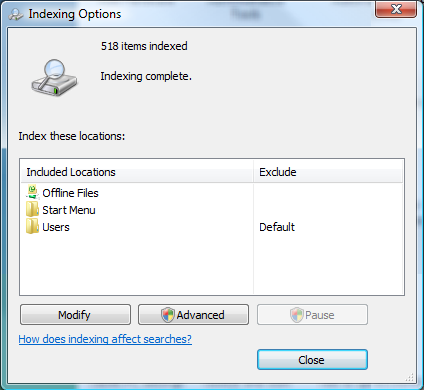
This page describes the new and improved Windows Vista features like Start Search, burning CD's and DVD's with the Windows Explorer, the Command Prompt, Windows Photo Gallery, Parental Controls, the Task Scheduler, the Snipping Tool, the Backup Center, the Mobility Center (for mobile computing), the Sync Center and the Sync Center (for synchronization between computers, servers and mobile devices like PDA's and MDA's).
The search feature of the Start menu (Start, Start Search) is quickly available and more advanced then the search feature of previous Windows versions. Because the indexing of files is more advanced, the search results are shown much faster. By default, the personal files and the mail archive (both Windows Mail and Outlook) are indexed, which speeds up searching for content in those files. Indexing of files is a continuous process which takes place when the computer is not actively used. That's why it can take some time before all files are indexed; especially when there are many files to index (disable the hibernation temporarily if there are many files to index).
Changing the indexing options
Select Indexing
Options in the Control Panel to change the indexing settings. This window
shows how much files are indexed already. New files which are added to the
already indexed folders will be indexed automatically as well. To achieve the best
search results, it is important to let the system know which additional folders
to index. To add (or remove) folders to the already included locations click the button Modify, button
Show all locations
and select the folders to index. If the folders with personal files have been moved to a different location/partition, add the new location to the folders to
be indexed as well.
|
|
The button Advanced offers some additional settings, like rebuilding the index (if there seems to be a problem) or moving the indexing location (the location containing the indexed information, which is useful in case of restoring a system image). The page optimizing the Windows Services tells how to disable the search feature in case it is not used.

Using the Windows Explorer to search
The Windows Explorer can be used to search for files within
folders/partitions (the Windows Explorer search function is quite useful to find
a file in case the storage location is not known). Searching is done by right
clicking a folder or partitions and to select Search. If the location
has not been indexed, searching can take some time (which is visually shown with
the horizontal bar which fills with the color green from left to right). In
some cases an additional yellow bar is shown with the remark Search might be slow in non-indexed locations: xxxx:\. Click to add to
index... . By clicking this bar, the location is added to the indexed
folders. To find a file, it is not necessary it is indexed but indexing will
speed up the searching process.
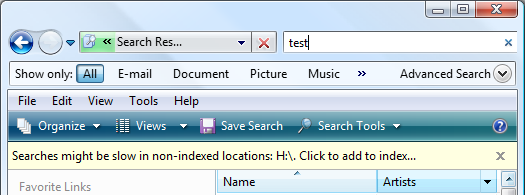
TIP: By default, system and hidden files will not be added to the search results, to add these files as well click the button Advanced Search and enable the option Include non-indexed, hidden and system files (might be slow).
Windows Media Center (added to both Windows Vista Home Premium and Ultimate) can be used for multimedia purposes. If the computer has got a TV tuner which is supported by Windows Media Center, it is possible to watch TV (broadcasted by cable), unfortunately the number of internet broadcasts is limited. Using the online TV guide, favorite programs can be recorded and stored on the hard disk using the MPEG2 file format.
Within Windows Vista CD's and DVD's can be burned without additional software. Place a CD-R(W) or DVD±R(W) in the CD/DVD burner and if asked format it in the desired format. Copying the files to the burner, using the Windows Explorer and select the option Burn in the menu bar to burn the files on the CD/DVD. Burning music CD's is done with the Windows Media Player!
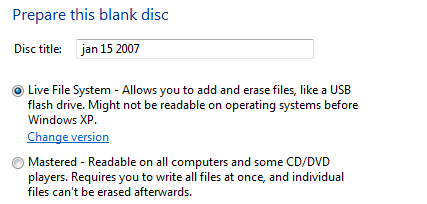
Windows DVD Maker and Windows Movie Maker (Start menu, All Programs) are available in Windows Vista Home Premium and Windows Vista Ultimate. Windows DVD Maker makes it possible to create a personal video or picture MPEG2 DVD (a file format which is recognized by most DVD players). To change the basic settings (like the DVD playback settings, DVD aspect ratio and the used video-format) follow the link Options at the right bottom of the window. Windows Movie Maker is especially useful to edit the video files using a storyboard with a timeline and the possibility to split and merge video files and to add effects, transitions, audio and background music. The button Publish Movie starts Windows DVD Maker, to burn the movie on a DVD. Both programs require a graphical card with support for DirectX 9.
A new picture management program Windows Photo Gallery (to import, manage and edit pictures) has been added to Windows Vista. The program automatically detects new pictures on the hard disk and is able to sort them based on storage location, date, label or a classification by the user based on a 5 star system (the classification is stored into the file). Windows Photo Gallery makes it possible to send pictures by e-mail easily (if desired, the file size can be decreased to decrease the time to upload and download). The button Make a Movie will start Windows DVD Maker, to quickly create a photo DVD. Check out Google's photo management tool Picasa for a better free alternative.
TIP: In case the slideshow of Windows Photo Gallery doesn't work (anymore), it can be caused by the limited capacity of the graphical card. This is probably solved by adding the DWORD value WinSATScore with the value 0 to the registry key HKCU\Software\Microsoft\Windows Photo Gallery\Slideshow. If it didn't help, add the DWORD value ForceSoftwareRender with the value 1 to the registry key HKLM\SOFTWARE\Microsoft\Windows Photo Gallery as well.
Parental Controls (available in the Control Panel) is the place to be to disable or limit the functionality (like the use of the PC and the internet connection) of the user accounts of your children. The first step is to make sure the other user accounts don't have access to the administrator accounts (see User Accounts in the Control Panel).
By default, the Command Prompt is not running with administrator rights, which limits the use of commands. Starting the Command Prompt with administrator rights can be done by right clicking the shortcut Command Prompt (Start menu, All Programs, Accessories) and to select Run as administrator. Running the Command Prompt as administrator by default is possible by right clicking the shortcut and to select Properties, tab Shortcut, button Advanced and to enable the option Run as administrator. The command CMD (in the search field of the Start menu) gives much quicker access to the Command Prompt. To run the Command Prompt as administrator, hold down the key combination CTRL-SHIFT while confirming the command CMD with the ENTER key.
The Windows Vista Command Prompt has two new commands: MLINK (to create a link to a file or folder) and ROBOCOPY (to copy files with more options then the commands COPY and XCOPY). Use the commands MLINK/? and ROBOCOPY/? for a more detailed description of these new commands. The command MLINK is very useful to move the Windows Calendar database (for more information, visit the page Windows Mail). The options of the command CACLS (to display or modify the access control lists of files) has been limited, use the command ICACLS instead.
OPENING A FOLDER IN THE COMMAND PROMPTThe Command Prompt is started with the command CMD in the search field of the Start menu, just like in previous Windows versions. The Command Prompt however always opens in a default folder, navigating to the desired folder with the command CD always took some time and effort. A new option in the context menu (available by right clicking a folder in the right pane of the Windows Explorer) makes it possible to open a folder with a few mouse clicks. To be able to see the option Open Command Window Here in the context menu, hold down the SHIFT key simultaneously. Why is this option not available in the previous Windows versions? |
The Snipping Tool (Start menu, All Programs, Accessories), new in Windows Vista, is a useful tool capture (a part of) the current screen. A red selection ink is added to the captured screen, disable the option Show selection ink after snips are captured (button Options) to remove this red selection border.
Thanks to the Task Scheduler (available in the Control Panel, option Administrative Tools) many Windows tasks are triggered automatically and run when the conditions are met. One of those tasks is the weekly defragmentation of the hard drive (a default Windows setting), which can be found by Task Scheduler, Task Scheduler Library, Microsoft, Windows, Defrag. Double click a task to edit the settings. The different tabs and options speak for themselves. The option Create Task (in the right Action pane) makes it possible to add tasks, which is useful to automate certain tasks!
The Backup Center in Windows Vista Business-, Ultimate- and Enterprise can be used to create a backup of specific files and folders and to create an image of the whole hard drive (a system image). This functionality is very useful in addition to Windows System restore and/or the use of shadow copies of (personal) files.
Backup files
The Backup Center (available in the Control Panel) can be used
to create a backup of files and folders and to store them on a another partition,
second hard drive, a network location, an external hard drive or to burn them on
a CD or DVD. After creating the first backup, a synchronization task can be
planned to make sure that the future changes will be added to the
backup as well. Because the backup procedure is a background process the computer can be used as usual.

Unfortunately, there are not that many settings available. Besides that, an automated backup procedure is not always the best available option (especially in case of an external hard drive which first needs to be turned on). An automated backup procedure also has the disadvantage of accidently overwriting backup files with incorrect files. That's why synchronization software like SyncBack is a better alternative to the automated Backup Center.
Backup entire computer
The Backup Center makes it possible
to create an image of the whole Windows partition as well. Although this backup
procedure is very fast, it takes a lot of space to store the image. The image
can be restored with the advanced boot options of the safe mode (press F8
while Windows boots) or by booting the Windows Vista installation DVD (select Repair your computer, select the Windows Vista operating system to
repair and select Windows Complete PC
Restore in the window System Recovery Options). For
creating and restoring a system image,
it is also wise to use external software instead. It takes more time to set it
up, but creating and restoring an image will be faster and more efficiently.
TIP: If the backup message in the system tray starts to annoy, disable the service Windows Back-up.
The Windows Mobility Center (available in the Control Panel) offers a quick access to multiple functions and configuration settings for mobile computing. The Center offers functions like adjusting the volume level, connecting a second display, battery status, screen brightness and turning on/off the wireless network. The Mobility Center is also available with the key combination Windows key-X.
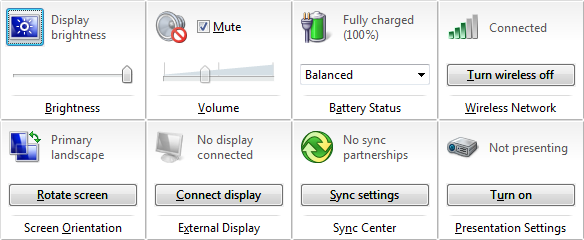
The Sync Center (available in the Control Panel) is used for synchronizing multiple computers and mobile devices. Synchronizing is only possible if both computers are attached to the same network and one of the computers has access to a shared folder on the other computer. For every connected computer, a synchronization partnership has to be created to make sure that the Sync Center automatically starts the sync job after the hardware is connected to the computer or the shared folder becomes available. For synchronizing mobile devices (like a PDA or MDA), the Windows Mobile Device Center is the place to be (see below). In combination with the Sync Center it makes sure that mobile devices stay synchronized.
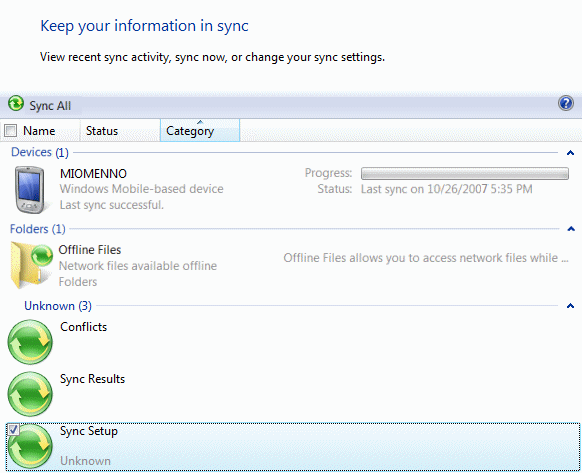
Offline access to shared network folders
By making network files offline available, you have access to copies of the
network files even when these files are unavailable for the moment because the
computer is turned off or temporarily not attached to the network. If the
network location becomes available again, a synchronization of both locations
will start. At synchronization the original network files will be overwritten by
the offline files (or the local offline files will be overwritten by the network
files in case someone else made changes to it). A network folder becomes offline
available by right clicking the folder and to chose for Always available
Offline. A mapped network drive (where a disk letter is attached to the
shared network folder) can be made available offline as well (press the left ALT
key to show the Windows Explorer menu bar, Tools, Map Network Drive, for
more information visit the page about
sharing files
with a mapped network drive). Click Offline Files in the Control
Panel to view the current offline files and to make some changes to the default
settings. Visit the page
automatically backup and restore files with SyncBack for alternative
synchronization software.
OFFLINE MAPPED DRIVES CAUSES A DELAYMapping a network drive has one big disadvantage: if the network location is unavailable, browsing through the files using a program (like Word) is annoyingly slow. Visit the page about sharing files with a mapped network drive for a batch file to create the mapped network drive if needed. Because the mapped network drive is not created by default, it can't cause a delay either. |
Synchronizing a mobile device (PDA, MDA) is a common task nowadays. The badly functioning ActiveSync (for Windows XP) has been replaced by the Windows Mobile Device Center (this center is added to the Control Panel automatically after connecting a mobile device). To get full functionality, additional software must be downloaded and installed. Without this software, it is not possible to synchronize the mobile device in the Sync Center. This software is downloaded and installed automatically after connecting the mobile device, but is also available on the Microsoft website (www.microsoft.com).
After installing the additional software for the Windows Mobile Device Center, it becomes easy to create a partnership. In the new center the synchronization settings for the contacts, Calendar, e-mail, task, notes, mobile favorites and files can be changed. After changing the default settings, the mobile device will be synchronized automatically after the connection with the computer has been made (the icon for the Sync Center will be shown in the system tray). Visit the Microsoft website for more information.
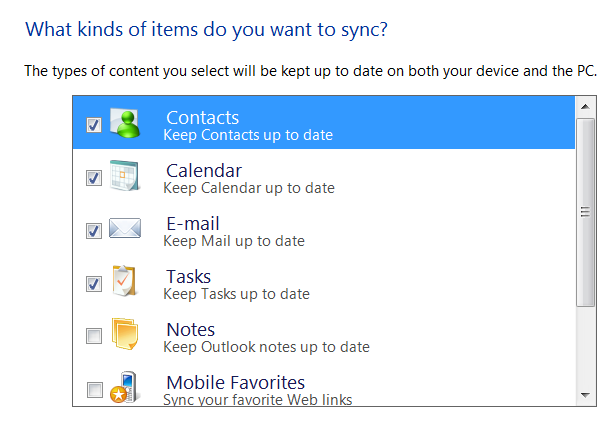
© 2001-2022 - Menno Schoone - SchoonePC - Rotterdam - The Netherlands